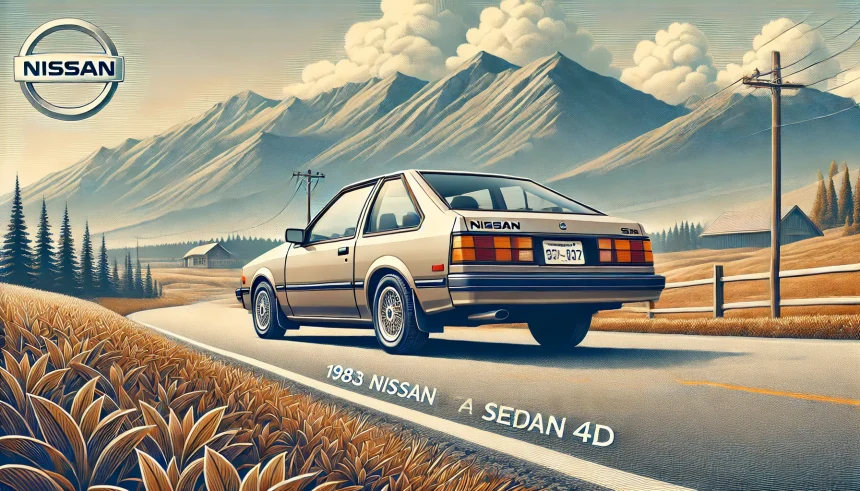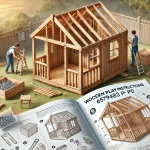The 1983 Nissan Stanza SE Sedan 4D was a compact four-door sedan known for its practicality and efficiency. It was designed for everyday use, offering a balance between affordability and reliability.
Nissan introduced the Stanza as a competitor to cars like the Toyota Camry and Honda Accord. It provided a comfortable ride, decent fuel economy, and simple mechanics.
This model featured a front-wheel-drive (FWD) layout, which improved handling and traction. Its design made it ideal for city driving while also being capable of highway cruising.
The SE trim added some premium features, making it a more desirable option among Stanza models. Drivers who wanted a compact car with a bit more comfort and style often chose this version.
Even today, the 1983 Nissan Stanza SE Sedan 4D remains a nostalgic choice for enthusiasts who appreciate classic Japanese cars.
Design and Exterior
The 1983 Nissan Stanza SE Sedan 4D had a boxy design typical of the 1980s. Its sharp angles and clean lines gave it a functional yet stylish look. The squared-off headlights and grille added to its simple but recognizable appearance.
This sedan had a four-door layout, making it practical for families and daily commuters. The design focused on maximizing space while keeping the overall size compact.
Compared to earlier models, Nissan made some aerodynamic improvements. These changes helped reduce wind resistance, slightly improving fuel efficiency and performance.
The SE trim came with sportier touches, such as alloy wheels and unique badging. Some versions also had body-colored bumpers and extra chrome details for a more premium feel.
Color choices for the 1983 Nissan Stanza SE Sedan 4D included neutral tones like silver, white, and beige, along with some darker options like blue and black.
Interior and Comfort
Inside, the 1983 Nissan Stanza SE Sedan 4D offered a simple but functional cabin. The dashboard had a straightforward layout, with easy-to-read gauges and basic controls.
Seating was designed for five passengers, with adequate legroom and headroom. The seats were available in cloth or vinyl, depending on the trim level.
Higher trims, like the SE, included additional comfort features. These included power windows, door locks, and an upgraded audio system.
- Some models came with air conditioning, which was a desirable option at the time.
- A sunroof was also available, adding an extra touch of luxury.
The cabin was well-insulated for its time, keeping road noise to a minimum. While not as advanced as modern cars, it provided a comfortable and quiet ride.
Engine and Performance
The 1983 Nissan Stanza SE Sedan 4D was powered by a 2.0L inline-4 CA20E engine. This fuel-injected engine produced around 102 horsepower, providing adequate power for daily driving.
Acceleration was moderate, but the car focused more on efficiency than speed. It was designed for reliability, making it a good choice for long-term ownership.
The front-wheel-drive system gave the Stanza good traction, especially in wet or slippery conditions. This was a key advantage over rear-wheel-drive sedans of the time.
Fuel economy was one of its strong points. The Stanza offered decent miles per gallon, making it a budget-friendly option for commuters.
Owners appreciated the engine’s durability, as it required minimal maintenance when properly cared for. The 1983 Nissan Stanza SE Sedan 4D was known for lasting well over 100,000 miles with regular upkeep.
Transmission Options
Nissan offered two transmission choices for the 1983 Nissan Stanza SE Sedan 4D. Drivers could choose between a 5-speed manual transmission or a 3-speed automatic transmission.
The manual transmission was the preferred option for those who wanted better control and fuel efficiency. It allowed for smoother acceleration and was fun to drive.
The automatic transmission was more convenient but had fewer gears, limiting performance slightly. It was a good choice for those who prioritized ease of driving.
Fuel efficiency varied between the two options. The manual generally provided better gas mileage, while the automatic was more suited for city traffic.
Regardless of the choice, both transmissions were known for their durability. With proper maintenance, they could last for many years without major issues.
Driving Experience
The 1983 Nissan Stanza SE Sedan 4D provided a smooth and comfortable ride. Its suspension was tuned for everyday driving, offering a balance between handling and comfort.
Steering was responsive, making it easy to maneuver in tight spaces. It was well-suited for city driving but remained stable on the highway.
The FWD layout gave it good grip on wet or snowy roads. This was a benefit compared to older RWD models that struggled in poor weather conditions.
- The ride quality was comfortable, with minimal vibrations inside the cabin.
- The brakes were reliable, providing good stopping power for a car of its size.
Overall, it was an easy car to drive, making it a popular choice for families and first-time drivers.
Safety Features
Safety in the 1980s was not as advanced as today, but the 1983 Nissan Stanza SE Sedan 4D included some important basic features. Seat belts were standard for all passengers, providing essential protection.
The body structure was designed to absorb impact, helping reduce injury in a collision. The bumpers were also reinforced to handle minor impacts.
Unlike modern vehicles, this model did not have airbags or ABS brakes. However, its simple design meant fewer electronic failures, making it a dependable choice.
The Stanza’s handling and braking performance contributed to its overall safety. It had a predictable driving feel, reducing the risk of losing control in emergency situations.
For its time, the 1983 Nissan Stanza SE Sedan 4D was considered a reasonably safe compact car. However, by modern standards, it lacks advanced crash protection features.
Market Reception and Legacy
When it was first released, the 1983 Nissan Stanza SE Sedan 4D was well-received. Buyers appreciated its fuel efficiency, reliability, and affordability.
It competed closely with the Toyota Camry and Honda Accord. While it may not have been the most powerful car, it delivered dependable performance for daily use.
Over the years, many Stanza models lasted for decades with proper maintenance. This helped establish Nissan’s reputation for producing durable, long-lasting vehicles.
The Stanza was eventually replaced by the Altima in the 1990s. However, its legacy remains strong among classic car enthusiasts who appreciate Japanese cars from the 1980s.
Today, finding a well-maintained 1983 Nissan Stanza SE Sedan 4D is rare, but some collectors still seek them out for restoration projects.
Conclusion
The 1983 Nissan Stanza SE Sedan 4D was a practical and reliable compact car. It offered a comfortable ride, good fuel economy, and simple mechanics that made it easy to maintain.
Its design was straightforward yet functional, making it a great choice for families and commuters. The SE trim added some extra features that made it more appealing.
While it may not have had the most advanced technology, its durability made it a long-lasting vehicle. Many owners appreciated its low maintenance costs and dependable performance.
Today, the Stanza holds a nostalgic value for those who remember its role in Nissan’s history. It may not be a high-performance classic, but it remains a symbol of reliability from the 1980s.
For anyone interested in vintage Japanese sedans, the 1983 Nissan Stanza SE Sedan 4D is a great example of a well-built, no-nonsense car from that era.
FAQs
How fuel-efficient is the 1983 Nissan Stanza SE Sedan 4D?
It offers decent fuel economy, averaging around 25-30 MPG, depending on driving conditions and transmission choice.
What makes the SE trim different from other Stanza models?
The SE trim includes premium features like alloy wheels, power windows, and an upgraded interior for added comfort.
Is the 1983 Nissan Stanza SE Sedan 4D a good car for collectors?
Yes, but well-maintained models are rare, making it a niche choice for enthusiasts of vintage Japanese cars.
Does the 1983 Nissan Stanza SE Sedan 4D have modern safety features?
No, it lacks airbags and ABS, but it has reinforced bumpers and seat belts for basic safety.
How long can a 1983 Nissan Stanza SE Sedan 4D last with proper maintenance?
With regular upkeep, it can easily surpass 150,000 miles due to its durable engine and simple mechanics.













